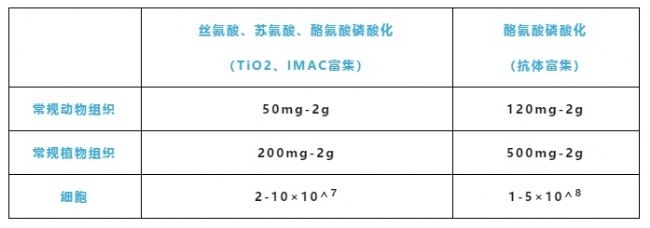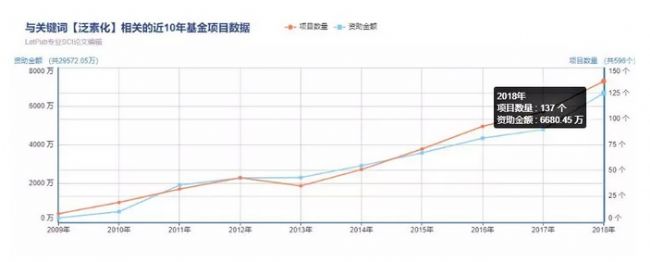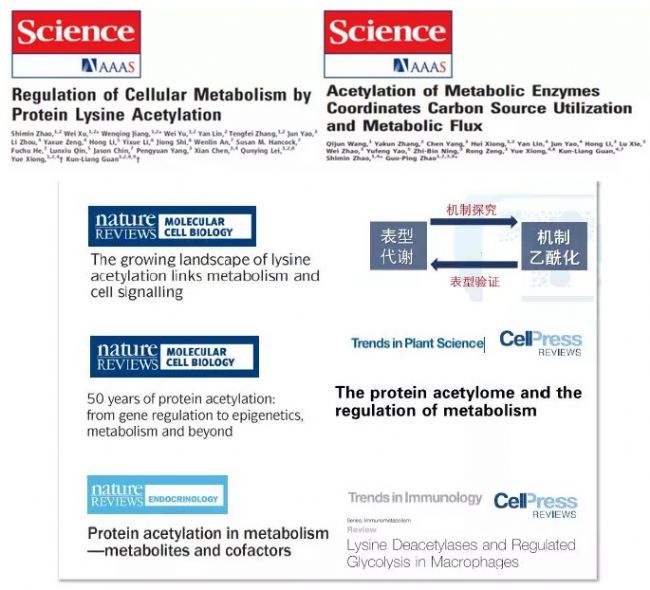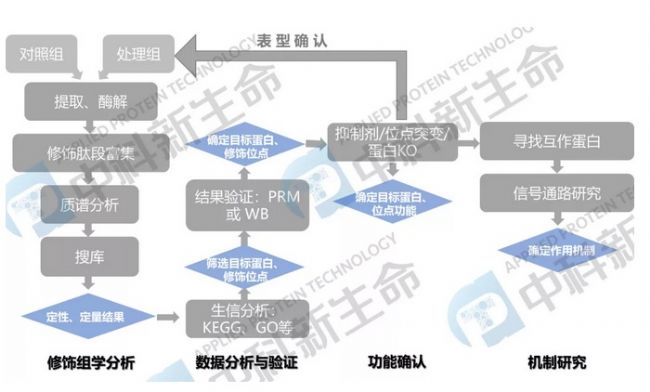At the beginning of March each year, it is the countdown to the "high school entrance examination" in the scientific research field, because the deadline for applying for the National Natural Science Foundation has been less than half a month. Throughout the natural application of the country over the years, post-translational modification of proteins is one of the major research directions in the application. In 2018, the national natural statistics show that the total amount of research grants related to phosphorylation, ubiquitination and acetylation is more than 200 million .
After last week's analysis of the intestinal microbiological research program (National Natural Sprint: a research strategy for breaking through the diversity and function of the flora), this week we will take the time to share with you the trends and groups of various types of modifications in the country's nature. The considerations for studying research are to help teachers. Below we focus on the three most common types of modification, phosphorylation, ubiquitination, and acetylation.
Stable performance: phosphorylation - the king of all-round regulation
Phosphorylation is the king of omnipotent regulation in modification, and its research is the earliest, and it has a wide distribution and the most modification. In eukaryotic cells, about 1/3 of the protein can be phosphorylated at any time, and it is involved in almost all physiological and pathological processes. Therefore, phosphorylation modification is the most widely recognized and focused study of all modifications.
â–² Application of phosphorylation modification in the National Natural Science Foundation over the years
In summary, in the application of the National Natural Science Foundation, the number of projects funded by phosphorylation and kinase-related research over the years has been large and the amount is high . However, its mature research base has also stabilized its annual fund-funding trend. According to the fund statistics of 2018, there are 105 projects related to phosphorylation, with a subsidy of 47.68 million, and 140 projects related to kinases. The amount of funding is as high as 64.149 million, of which 2 are key projects. Therefore, phosphorylation can be said to be a very stable direction in a modified fund application.

Figure 1. National Natural Science Fund Project Statistics - Phosphorylation
â–² Technical attention points of the phosphorylation modification omics research program:
â— How to choose the phosphorylation modified peptide segment enrichment method?
Since there are three kinds of amino acids which are phosphorylated, serine, threonine and tyrosine, the enrichment method of the phosphorylated peptide is different depending on the research purpose. At present, the more mature phosphorylation enrichment methods mainly include: metal chelate enrichment (such as TiO2, IMAC enrichment) and antibody enrichment.
Metal chelate enrichment is the most commonly used enrichment medium for teachers who are concerned with modifications at all three amino acid positions. Its enrichment efficiency is high, usually can reach more than 90%, and some of the commercial IMAC kits have ideal enrichment stability.
For teachers who focus on changes in tyrosine phosphorylation modification (for example, many focus on the research of receptor tyrosine kinases in the field of tumors), the use of TiO2 and IMAC cannot meet the requirements. This is due to tyrosine. The proportion of acid phosphorylation modification is very low, accounting for only 1% of all protein phosphorylation. Therefore, for this type of analysis, antibodies with tyrosine-specific motifs are often used for enrichment in order to obtain the best results ( AFP) uses the gold standard of the antibody--CST antibody for tyrosine Enrichment of phosphorylation ).
â— For the purpose of subsequent results validation or targeted detection, what if there is no antibody to the modified site?
Mass spectrometry-based PRM technology is one of the best choices for subsequent validation or targeted site-targeted detection of modified groups . The full name of PRM verification is Parallel Reaction Monitoring, which is a targeted quantitative technology based on the development of high resolution mass spectrometry. Because it only scans for specific target signals, it can achieve accurate quantification of target proteins and modification sites, and its application purpose is similar to Western blot.
PRM has been widely recognized and paid attention to in the industry. There have been many research applications in high-level research such as Nature and PNAS. In addition, PRM can quantify multiple proteins and modification sites at the same time, which is not only more accurate, finer and more efficient than traditional WB. At present, Zhongke New Life has launched a one-stop service for phosphorylation modification group + PRM verification to help teachers quickly solve the problem of verification.
â— What is the sample size requirement for the phosphorylated group?

The momentum is fierce: ubiquitination - a new perspective on the regulation of protein expression
Ubiquitination is the most special type of modification in all modifications. Proteins that are ubiquitinated are often further degraded by the proteasome (some also play a scaffolding role to promote protein complex formation, etc.), therefore, protein expression Level changes are often an important concern for ubiquitination. Ubiquitination modification, as important as transcriptional and protein level studies, is one of the important mechanisms regulating protein expression levels , but it is often overlooked by researchers, and it has relatively high research innovation.
â–² Â Application of ubiquitination modification in the National Natural Science Fund over the years
Judging from the fund application situation over the years, the number and amount of applications for ubiquitination modification have shown a rapid growth trend since 2013 , and the growth rate from 2017 to 2018 is the fastest in the past years. The statistical results show that there are 137 projects funded by the ubiquitination study in 2018, with a total funding of 66.845 million, of which 5 are key projects .
It can be seen that the ubiquitination-related funds are approaching phosphorylation regardless of the number of applications or the amount of funds, and even from the number of key projects, the number of ubiquitinated projects in 18 years has exceeded phosphorylation. Further statistics show that the ubiquitination research funded project has a total of 98 projects in the Ministry of Medicine, with a total funding of 47 million yuan. It can be seen that the related research on ubiquitination is the “red-small student†in the scientific research field, and the fund application is a hot spot .

Figure 2. National Natural Science Fund Project Statistics - Ubiquitination
In addition to funds, in recent years, ubiquitination has appeared frequently in top CNS magazines, and has become a hot topic in CNS magazine review, from various physiological processes, to diseases such as cancer and aging, to drug development. . It can be seen that its important role and great potential in the medical field are getting more and more attention, and it is expected to become the second largest star modification type after phosphorylation.

â–² Â Technical attention points of the ubiquitination modification group research program:
â— Selection of ubiquitinated modified peptides?
At present, the enrichment of ubiquitin-modified peptides is still enriched by lysine-modified motif antibody (K-GG) ( again, the new life of Zhongke is enriched with antibodies from CST ).
â— How to interpret the results of the ubiquitination modification group? What are the points of attention for subsequent verification?
Since the ubiquitinated protein is likely to be involved in subsequent protein degradation, teachers will not be considered ubiquitinated if they find that the expression of ubiquitination is reduced in the results of the ubiquitination group. The level of modification is reduced! It may be due to a decrease in the level of modification or an increase in the level of modification, which is a very different interpretation of the results of ubiquitination and other modifications. Because the increase in ubiquitination can directly lead to protein degradation, if the protein undergoes ubiquitin-proteasome degradation, the amount of modification is also reduced with protein degradation. Therefore, for teachers who conduct cell-level studies, we recommend using MG132 to pre-treat cells to inhibit the degradation of ubiquitin . For the subsequent verification of ubiquitination modification, it is not only necessary to verify the change of the modification level, but also to verify the protein level .
â— What is the sample size requirement for the ubiquitination modification group?
Recommended: regular animal tissue samples 120mg-2g; conventional plant tissue samples 500mg-2g; cell samples 1-5×10^8 cells
Another way: acetylation modification---the regulation mechanism behind metabolic performance
Compared to phosphorylation and ubiquitination, acetylation studies are more concerned with their apparent regulation of histones, while non-histone acetylation modifications are relatively rare. In particular, the extensive regulation of acetylation on metabolic processes is a pioneering discovery that has only been recognized in recent years.
â–² Â Application of acetylation modification in the National Natural Science Foundation over the years
Judging from the application situation of funds over the years, the performance of acetylation modification is not backward. The number and amount of projects applied by relevant research institutes are increasing year by year, and the growth rate in the past two years (2016-2018) The fastest. In 2018, there were 111 funded projects for acetylation research, with a total funding of 54.26 million and 2 key projects. Among them, the Ministry of Medicine's acetylation research funded projects accounted for 48 projects, a total of 38 million yuan.

Figure 3. National Natural Science Fund Project Statistics - Acetylation
In fact, acetylation has been studied for 50 years. In addition to histones, there are a large number of acetylated modified proteins in cytoplasm, mitochondria, etc., which have a wide range of biological functions such as signal transduction and autophagy. Regulation. In 2009, SCIENCE published two studies at the same time, bringing acetylation research to a new level. One of the reports reported that more than 1000 acetylated proteins were found in the liver, and such modifications were common in metabolic enzymes. Thus, acetylation-mediated metabolism became a textbook-level discovery, and the regulatory mechanism behind metabolic phenotypes. -Acetylation has become a new field of metabolic regulation research. In the past few years, there have been frequent hot reviews of "acetylation and regulation of metabolism".

From the study of omics, acetylation regulates metabolism from a very novel point of view, which makes the exploration of acetylation function not limited to histones. Therefore, the modified group combined with the metabolome for research is a research strategy for the mechanism and phenotype, and it is a more complete and innovative research program of the National Natural Science Foundation.
â–² Â Technical note points for the acetylation modification group study protocol:
â— How to choose the acetylation modified peptide segment enrichment? What is the sample size requirement?
Enrichment of acetylated modified peptides is mainly enriched by lysine acetylation motif antibodies (again, modified human antibodies using CST).
â— What are the requirements for the sample for the joint analysis of the acetylation group + metabolome?
For the union, ensuring consistency between the two omics samples is key. Therefore, in combination with acetylation and metabolism, we recommend that the sample sources of both omics are consistent. If a teacher wants to further use correlation analysis for in-depth data mining, the number of sample repetitions between the two ensembles should also be consistent.
â— What is the sample size requirement for the acetylated modification group?
Recommended: regular animal tissue samples 120mg-2g; conventional plant tissue samples 500mg-2g; cell samples 1-5×10^8 cells
to sum up
Throughout the history of the country's natural application, modification is one of the major research directions in the application. By 2018, the country's natural, phosphorylation, ubiquitination, and acetylation, each type of modification type of project funding amounted to more than 50 million, the total research grant amount of the modified direction exceeded 200 million.
Nowadays, with the development of research technology, mass spectrometry is one of the most important techniques for studying post-translational modification. It is more and more widely used in the research of modification, and it is more and more compatible with traditional molecular biology. High-level research.

Figure 4. Complete research ideas for the combination of modified groups and traditional biotechnology
If teachers need detailed technical methods and materials, please feel free to contact us.
Protein|modification|metabolism|lipid|structural confirmation
T: 021-54665263
E:
Q: 1875681852
Food additives refer to chemically synthesized or natural substances added to food in order to improve the quality, color, aroma and taste of food, as well as for the needs of antiseptic and processing technology. Due to the rapid development of the food industry, food additives have become an important part of the modern food industry, and have become an important driving force for technological progress and technological innovation in the food industry. In the use of food additives, in addition to ensuring that they play their due functions and roles, the most important thing is to ensure the safety and hygiene of food.
Our company provides chemical food additives, natural food additives, etc.

Food Additives,Beverage Additives,Malic Acid Powder,Natural Food Additives
XI AN RHINE BIOLOGICAL TECHNOLOGY CO.,LTD , https://www.xianrhinebiotech.com